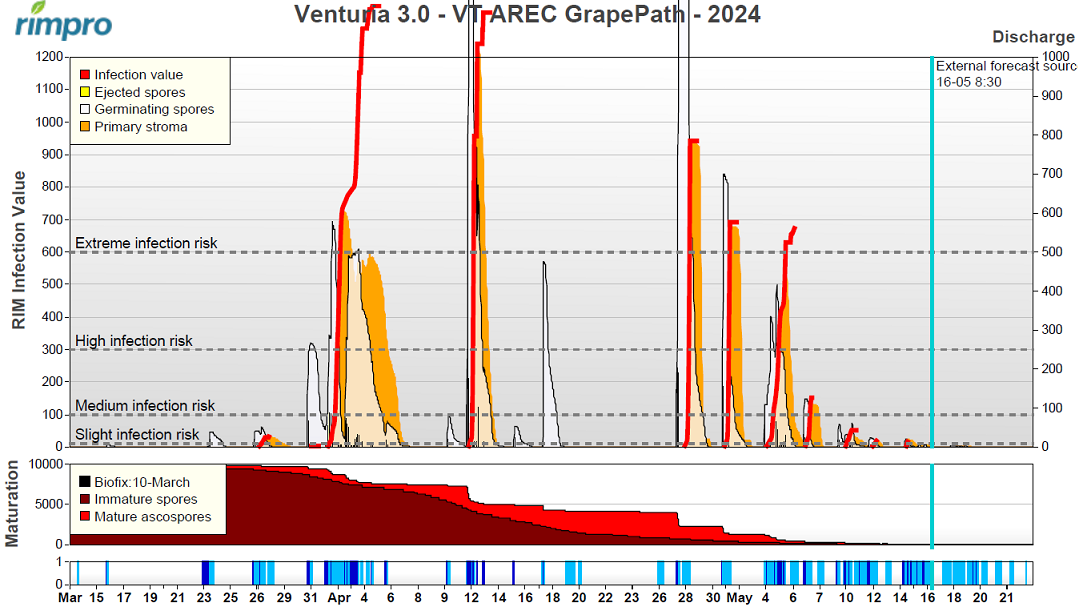1. Fire Blight Visible as of 5 May in Northern VA; 2. Rust and Powdery Mildew Visible as of 15 May in Northern VA; 3. Primary Scab Season Over But Cedar Apple Rust Still a Significant Risk
1. As of last week (5 May), first fire blight symptoms are visible in Frederick and Madison counties in Virginia (Fig. 1, 2). We are aware that symptoms of fire blight were visible in Southern Virginia much earlier. Based on the time when these symptoms were first seen in Frederick and Madison counties and looking at the RIMpro Erwinia fire blight incubation model, we can confidently estimate that these symptoms are the result of natural fire blight infections that occurred with wetting events between 15-19 April (Fig. 3). We we were at full apple bloom in that period in Winchester area (e.g. apple cultivar ‘Fuji’). If in your orchard you see more than 3% blossom blight symptoms, you have active infections taking place on actively growing shoots. If you see uniform dispersed fire blight strikes across your orchard assume that the fire blight bacterium will be present for a long time and you will be at a high risk from when the first flower open until terminal bud set on shoots in several future years. You will require protection of flowers each spring when models like Maryblyt or EIP in NEWA predict infections risks. If you see fire blight symptoms now, do not apply streptomycin, as the bacterium is already deep inside the green tissues, so it cannot be reached by the antibiotic, and there is a significant risk that you will promote streptomycin resistance development in the fire blight bacterium Erwinia amylovora. Due to this risk of resistance, we never recommend using streptomycin when symptoms are visible. The only exception is a hail event when you can use this antibiotic within 24 h after hail to prevent trauma blight. Applications of streptomycin when symptoms of fire blight are visible, and there is no hail as justification to use it, lead to resistance which in turn leads to reduced antibiotic efficacy or even worse, complete loss of its efficacy.
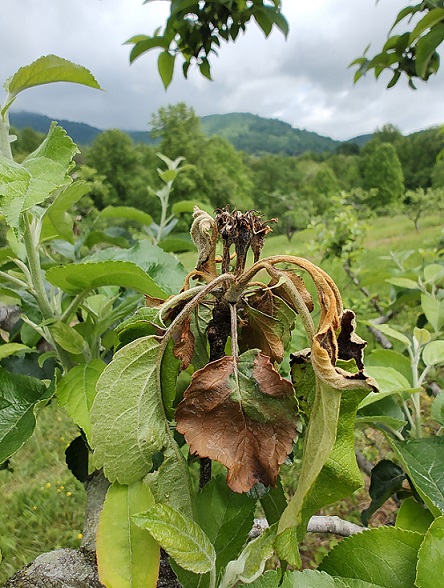
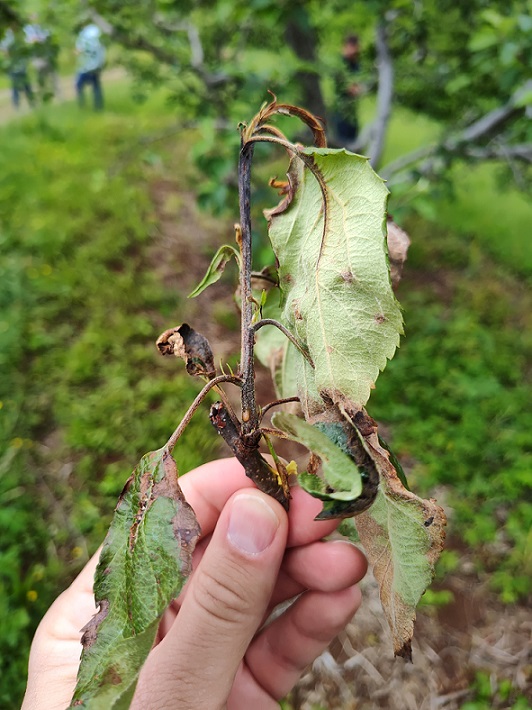
Figures 1 and 2 showing first symptoms of blossom blight in Madison county VA (Photo by Acimovic S. G. 2024).
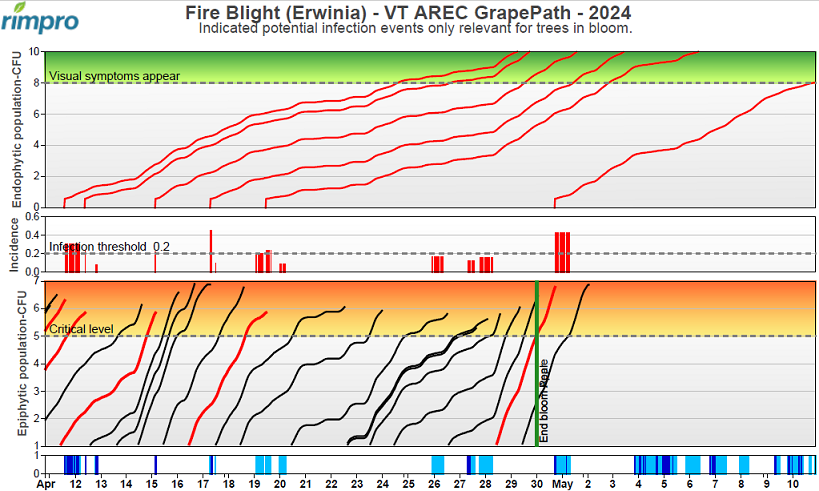
At this time, if symptoms are visible, apply plant growth regulator (PGR) prohexadione-calcium (Apogee, Kudos) to harden off your shoots and this reduce susceptibility of not-yet-infected shoots. Apogee will no longer be available on market after 2024. However, Kudos will be. This material will also slow down the invasion shoots by the fire blight bacterium. This PGR works by inhibiting hormones of growth in the green tissues and thus reduces the vegetative tree growth i.e. shortens the shoot length. More importantly, prohexadione-calcium shortens the period of terminal shoot growth and bridges the time to terminal bud set. Because the trees are no longer susceptible to fire blight infections when shoots stop its growth i.e. when terminal buds set on shoots, application of Apogee or Kudos will speed onset of terminal bud formation, thus reducing the period of shoot susceptibility to infection and reducing the chance for spread of fire blight on other shoots. If symptoms are numerous, mature bearing orchards should be sprayed with 12 oz of Apogee per 100 gal, preferably in a dilute spray, to get a good coverage of all shoots. This will help reduce the number of fire blight cankers developing on wood by disease invasion from infected flowers and shoots. Management should also include applying a labeled copper material for fire blight during shoot growth (e.g. Badge X2 and Badge SC) at 0.2 lb/A of metallic copper equivalent. Use copper by avoiding slow drying conditions as it can cause fruit russetting. This is not a concern in cider apple orchards. Even a low rate like this can cause fruit russetting at slow drying conditions, especially if residue from multiple previous applications add up together at a significant rain event. After the copper spray and REI expiration, you can move into the orchard and prune fire blight symptoms off to reduce inoculum spread. Copper will only kill fire blight bacteria present on the plant surface, not inside the tissue. As per Dr. Yoder, keep in mind that copper can also cause purple spots on leaves, and the is aggravated with successive applications, so the older leaves may show more injury having received more
applications than younger leaves.
Due to recommended low copper doses and the fact that copper does not kill bacteria inside the infected tissues, the effect of copper will be to slow down or prevent further spread of pathogen to new, uninfected shoots. More spray applications may be needed to achieve the good effect. High rates of copper and copper applied just before wet and slow-drying conditions could injure fruit skin up through at least mid-June. Cultivar differ in their susceptibility to copper related russetting. You will need to take into account how prone is each of your cultivars to russetting by copper, so watch the weather forecast to avoid applying copper before wet and slow drying conditions, and apply low-doses of copper probably multiple times with lower water volume (to promote quick drying after spray). When considering use of copper, a tank mix of Cueva and Double Nickel might be the best choice since there are some indications that this mix may be less prone to cause fruit russetting.
If possible, remove fire blight symptoms as soon as they appear, after you applied Apogee or Kudos. Cutting out the infected strikes at 18 to 24 inches below the visible margin of infection on dead shoots or flowers aims to remove bacteria that might have penetrated into the symptomless wood far below the infection margin. If these length requirements below symptom edge could not be met, pruning should be done into the closest perennial wood (at least 2-yr-old, and 4-6 inches into this wood if possible). Prune on a cool dry day and never before, during or soon after rain of heavy dew. Dew and rain allow spreading fire blight more. All pruned out brush should be left on the ground, close to the tree, and flail-mowed or removed from the orchard after the branches are completely dry (cuts show no green cambium visible when bark is scraped with a knife). If there is enough space in the mid-rows to leave the brush on the ground, without preventing passage of air-blast sprays with a tractor, copper could also be applied after pruning. During symptom removal, pruning tools should be disinfected at least between each tree with 70% rubbing alcohol or 10% bleach solution. Even though the true benefit of using any specific disinfectant for tools is still debated or questioned, I would recommend using one of these disinfectant solutions. If pruning is done rapidly, as soon as first symptoms occur, continue scouting daily after the first pruning to remove any additional strikes that develop subsequently.
2. Juniper rusts are still viciously active and recent and future rain events are still releasing basidiospores from cedars to infect apple leaves and fruit. You should still apply Sterol Inhibitor (SI) also known as DMI fungicides like Inspire Super, Cevya, Rally, Sonoma, Topguard, Rhyme or Procure + Manzate Pro-Stick, every 14 days for rust control. In between the SI/DMI fungicides apply SDHI fungicides Fontelis, Sercadis, Miravis or Excalia + Manzate Pro-Stick to protect against apple scab and powdery mildew. We found the first rust symptoms on ‘Gala’ at the AREC (Figure 4). Scab is just starting to show in Frederick county – we have pictures from AREC but will wait to see it develop a bit more in the same ‘Gala’ block and will report symptoms in a few days. The 2024 was conducive for scab infections. We also see first secondary infections on new leaves from powdery mildew (Figure 5).
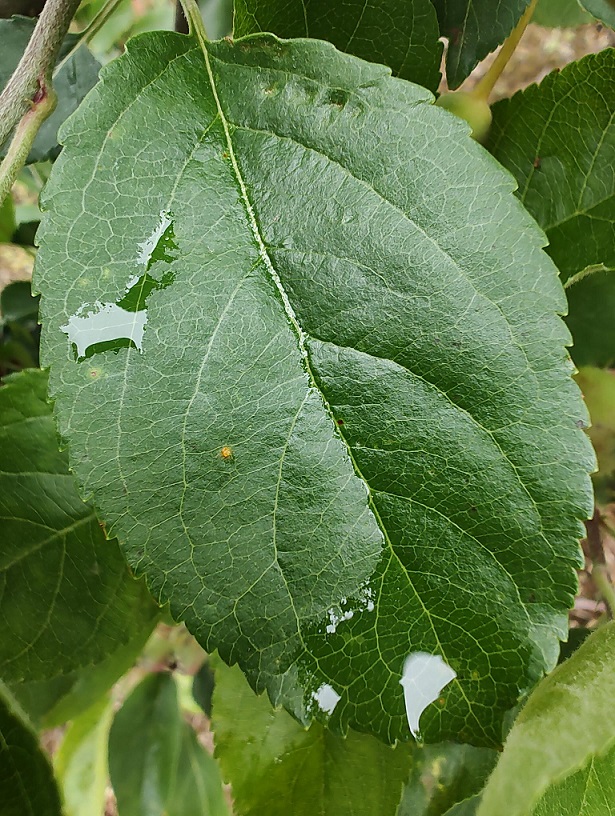
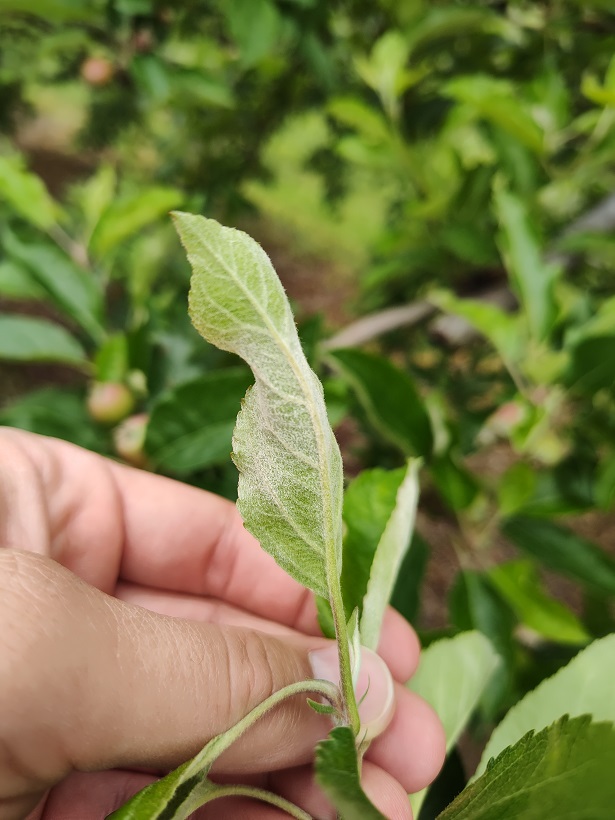
Figures 4 and 5 showing first symptoms of cedar apple rust and of powdery mildew on leaves of ‘Gala’ apple in Winchestrer VA (Photo by Acimovic S. G. 2024).
3. We had 5 major apple scab infection periods in Winchester (Figure 6). In other parts of Virginia anywhere from 3 to 5 infections were recorded. Based on RIMpro model prediction, primary apple scab season has ended on 5 May 2024 in Winchester, Cross Junction and Timberville, and on 6 May in Quicksburg (ascospore number in the spore bank in the leaf litter on the orchard floor fell below 5%). Primary scab has season has likely ended in central and southern Virginia but we cannot report the exact date(s) for this stage as we do not have stations connected to RIMpro in these regions in 2024. Regardless of the primary scab season end date we report here, the fungicide coverage needs to be continued on a tight spray interval up to 2 weeks after the date of primary scab season end date. This is absolutely necessary because you do not know how good your coverage was in the major spring scab infection events and juniper rust infections warrant continued applications ahead. Many of you are using alternate row middle (ARM) spraying that should cease at bloom and you should spray every row from bloom onward. So, if any scab lesions arise now from coverage issues associated with ARM spray approach, or due to missed fungicide applications before any rains during early spring, it will be much harder to have scab-free crop until harvest. Risks from scab infections are now high in orchards where scab lesions are visible on leaves or on fruit. This is because asexual spores of apple scab fungus called conidia are available for infection. In those orchards protection from scab scab continues with higher rates of captan as the secondary infections by asexual spores called conidia, which is what is inside of the velvety scab lesions you see, and are now able to infect. Leaves are still expanding now on terminal shoots and can hold much more fungicide residues to protect from diseases, allowing some redistribution during low-amount rains.
